Do-it-yourself well cleaning: a review of the best preventative and capital methods
Any tank in use needs to be cleaned. And a well filled with surface water is no exception. But, even knowing the need for the regular conduct of this procedure, not all owners are ready to lay out large amounts for the services of specialists.
Some carry out cleaning on their own - the work is quite time-consuming and associated with certain risks. However, adhering to the methodology and observing safety precautions, it is quite possible to restore the source of water intake to its former purity without the involvement of professionals.
We will tell you why the reservoir is often clogged, describe how to do preventive and comprehensive cleaning of the well with your own hands, and also give tips on servicing the water intake point.
The content of the article:
When is the time to clean the well?
A well-made well can last for more than a dozen years. But even a well-equipped structure becomes polluted over time.
Falling foliage, dropped foreign objects cause biological processes. And metal impurities can even worsen its condition, making it potentially dangerous to human health.
A number of signs will indicate that it is necessary to clean a well in a country house:
- The water got an unpleasant odor and a strange taste.
- Well water changed color, filamentous fibers began to occur in its composition.
- Clay deposits formed on the walls of the structure.
- Dynamic and static water levels fell.
The quality of drinking water is recommended to be checked annually. The procedure is best performed in the offseason. Verification and well water analysis the concentration of impurities and substances in it is ordered in specialized laboratories of SES.
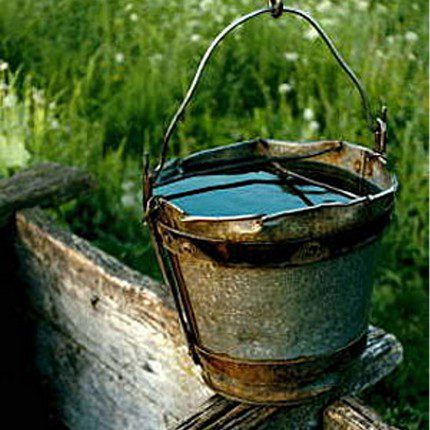
Causes of pollution
One of the main causes of water pollution in the well is the irregular use of the structure, as a result of which it is simply silted up.
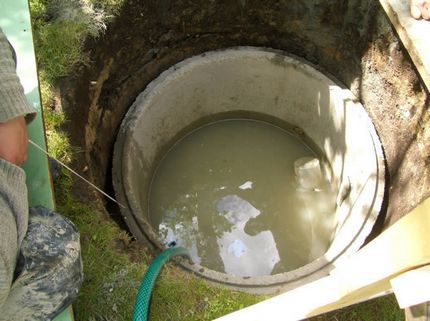
For the same reason, it is recommended to remove filters and submersible pumping equipment from it during the break in the use of the structure so that they do not fail prematurely. It is especially important to perform these actions in the winter.
Several other problems can also be a cause of deterioration in water quality. Let's look at each in detail.
Badly closing construction cover
The well should be open only at the moment when water is extracted from it. At other times, its neck should be tightly covered with a lid. Otherwise, dust and dirt in the air will certainly fall into the mine and "do their dirty work."

Incorrectly made shutter from meltwater
It should be a capital waterproof "layer" around the upper casing. The thickness of the clay castle should be at least 50-100 cm.
If this condition is not met, the overhead water will penetrate into the reservoir, which along with it carries garbage, waste products and washed out pieces of soil.
Rupture of suture joints
No matter how well the seams in the well are repaired, cracks can form in them during the annual freezing of the soil.
Through poorly sealed seams, surface groundwater seeps into the mine, which contains fertilizers and domestic wastewater. The situation can be corrected by repairing cracks with a mortar with the addition of liquid glass.
Offset design rings
The shift of structural elements is possible for various reasons, among them - improper installation and natural factors.
Ring Offset Options:
- At the bottom of the trunk - arises due to exposure to quicksand. We'll have to cover the place of separation with cement mortar
- Pushing the upper rings - occurs due to freezing of the soil. The sheared rings must be pulled together with thick wire pins.
To grout large joints, it is better to use "stretch" cement grade NTs-80 or 87. Material, characterized by increased elasticity, is used in the construction of the subway and underground tunnels.
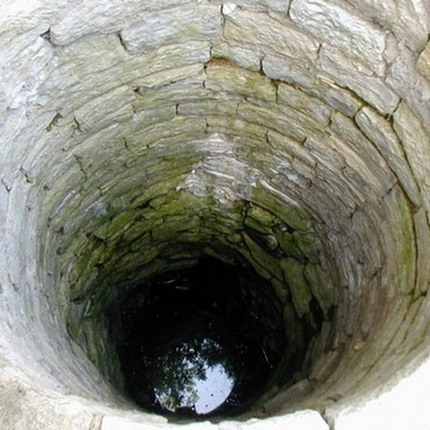
In order to unconditionally get rid of contaminants and eliminate structural defects, it is necessary to determine in advance how best to clean the well and, if necessary carry out tank repair.
Well Cleaning Technologies
The shaft of a mine type can be cleaned at the cottage in two ways: by traditional hand and using a drainage pump.
Manual cleaning method pretty simple. It includes two stages: mechanical cleaning and chemical.
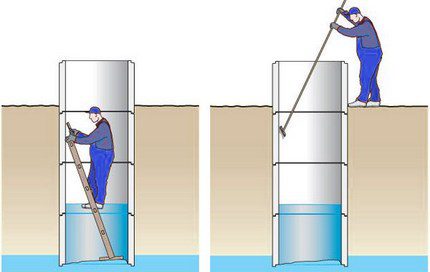
First, water is pumped out of the tank. Then a ladder is lowered to the bottom of the well, along which the cleaner will move during the work. Its task is to clean the bottom and walls of the shaft with a sponge or brush from a layer of dirt and accumulated mucus.
For wells used year-round, such cleaning is recommended once every 5-7 years. In the intervals between cleanings, it is only necessary to control the quality of the water.
If the analysis shows that the composition is in accordance with the norm, there is no need to “balamute the water” once again. Wells built in summer cottages, the operation of which is seasonal, need to be cleaned once a year.
Automated way consists in the use of a drainage pump that raises the sludge from the bottom and at the same time purifies the water.
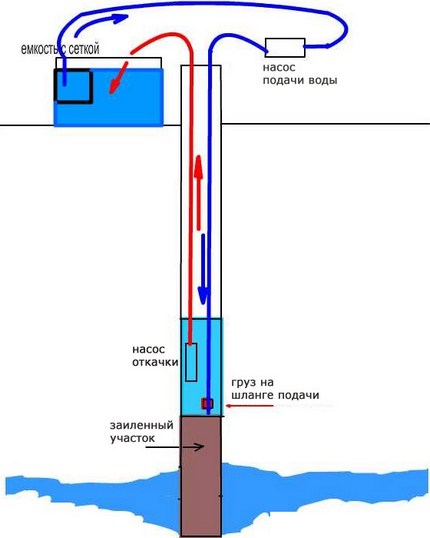
The cleaning of the hydraulic structure is carried out by the pump. The desired effect is achieved due to the water circulation created by the injection unit.
The liquid passing through the filter is cleaned, and then, under high pressure, is discharged back into the shaft, where it raises silty sediments from the bottom and directs them towards the filter.
Let's look at each of these two methods in more detail.
Preventive manual method
Timing for work
Masters specializing in the repair of hydraulic structures recommend cleaning the well in the country at the end of summer. This is due to the fact that by the end of summer the water balance of underground sources has a minimum debit of filling.
Categorically it is impossible to empty the mine during the spring flood. Water-saturated liquefied soil, on which, after emptying the tank, the water trunk ceases to exert pressure, can simply rush back to the mine.

If the well is operated only in the summer, preventative cleaning should be performed more often.
Since the "cleaning" measures are very time-consuming and unsafe, it is important to observe safety measures during the work. In this business, reliable insurance is indispensable.
Work is best done during daylight hours. For its production should attract a couple of assistants. One master will work in the mine, the other two will insure on the surface.
Keep in mind that at a depth level below three meters there is a lack of oxygen. Therefore, the task of assistants located on the surface is to monitor the health of the cleaner and, if necessary, by joint efforts to remove it from the mine.
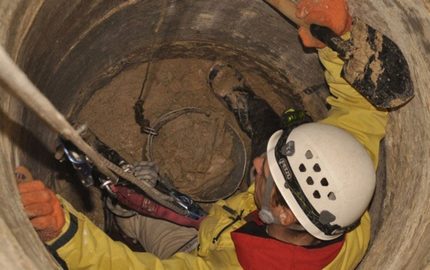
The cleaner must wear a safety belt to which the cable will be attached in the future. Before diving into the well shaft, make sure that there are no harmful gases at the bottom of the tank.
To do this, you first need to lower the bucket into the shaft with a candle lit in it on a rope. If everything is in order and there is no gas in the mine, the candle will continue to burn.
Preparation of necessary materials
For mechanical cleaning, you will need:
- stairs;
- supporting rods;
- safety rope;
- platform on the ropes;
- wooden swing for lowering a person;
- metal brush;
- scraper or hoe;
- spatula or trowel;
- felt or fur roller.
- bucket.
All safety equipment, including holding slings and a locking mechanism, can be rented.From materials it is necessary to prepare disinfectant compositions and concrete mortar.
It is advisable to equip the ladder on which the cleaner will work, with a support platform. It will help to distribute the load over a large area, minimizing the risk of "subsidence".
Mine drainage options
You can drain the shaft manually or using a pump. Hand-scooping out with a bucket is only effective if the source is slowly filling and has a shallow depth. However, while you pull out a filled bucket and pour it out of the area, the same amount of water manages to again be typed into the tank.

Units are of two types:
- Submersible - are located in the water column and work near the bottom of the mine. Effectively work both in clean and in contaminated water.
- Surface - the pumps are installed outside the well, and only the suction hose is lowered to the bottom. Such pumps are capable of pumping water from mines, the depth of which does not exceed 8-10 meters.
If the well is located on a quicksand, it cannot be completely emptied. This can lead to the fact that the swimmer will set in motion, and the water intake part of the structure as a result of this will quickly become silted.
Pumped water from the tank should be diverted to a sufficient distance. Otherwise, after a short period of time, it, seeping through the soil, will again be inside the walls of the mine.
Owners of wells installed on clay soils note that such pumping helps to restore and even increase the flow of water.
Under the influence of pressure resulting from the alternate decrease and increase in the level of the water column, not only the old clogged capillaries open, but also new ones appear.
Wall and bottom processing
Cleaning the walls of a well involves scraping off plaque from the inner surface of concrete rings. The upper one and a half to two meters of the mine is more convenient to clean from the ground, and the lower sections - from the stairs installed at the bottom of the well.
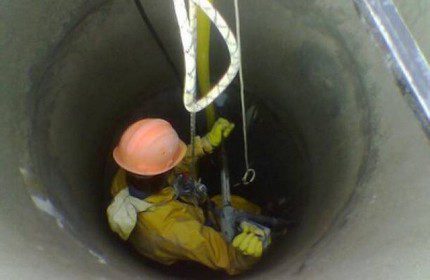
After cleaning the walls, the bottom filter is cleaned. It is usually made using three components: crushed stone, gravel and sand. Such a combination of materials with different structures makes it possible to ensure the highest quality water filtration.
To replace the natural filter, scoop out old gravel and sand with a bucket. The upper layers are recommended to be completely removed and replaced with fresh pebbles. The thickness of the layer of the filtering embankment should be at least 40 cm.
The progress of work is demonstrated in the photo report:
Sealing and reinforcing seams
The cleaned surface must be carefully inspected. All defects will be clearly visible on it.
It is easiest to strengthen damaged joints by coating them with concrete mortar, which includes hydrophobizing impregnations. They will provide waterproof construction.
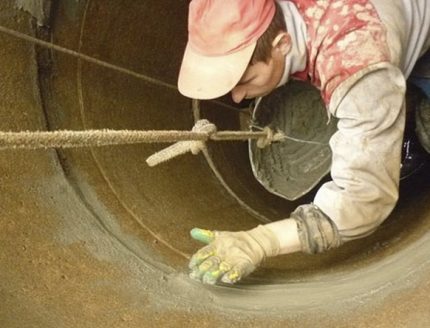
To fill large cracks, masters recommend using special formulations such as Penecritus or Penetron, forming with their help water seals.
"Impregnation" with chemical composition
After cleaning the bottom and walls of the well, the tank is sanitized. For this, the walls of the structure are covered with a 10% solution of bleach. Special formulations such as Whiteness, which can be purchased in hardware stores. The rest of the solution should be evenly distributed along the bottom of the shaft.
Wall treatment can be performed with a solution of ordinary potassium permanganate.
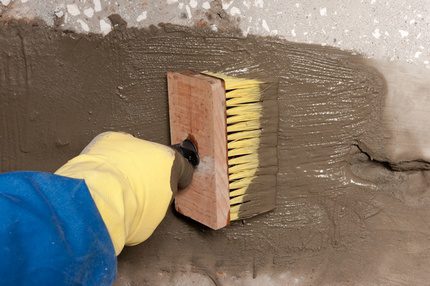
Since chlorine vapor is hazardous to human health, chemical treatment should be carried out with safety glasses and a respirator.
Commissioning after cleaning
Having completed the work, the pumping equipment is installed in the same place. Equipment filters can be cleaned with strong water pressure and flushing with special tools.
At the final stage, they wait for the natural filling of the well with water and leave it for two / three days. Then re-pump the liquid and refill the tank, assessing the condition.
Water should have a transparent color, be free from all kinds of impurities and unpleasant odors. Before using water for its intended purpose, let it settle. This may take another day or two.
Drain cleaning
Most of the cleaning operations in the well mine can be performed using technology. It is only necessary to organize the circulation of the liquid. For cleaning at the bottom of the well shaft set pump equipment. He will pump water to the surface.
The unit is installed on a stand with a width of 10-12 cm. This is necessary in order to prevent the device from being drawn into the sludge. The pressure hose of the unit is lowered to the bottom of a nearby storage tank. For this purpose, you can use an old bathtub or a three hundred liter barrel.
An injection unit is mounted to the upper part of the barrel, which will pump water back into the well.
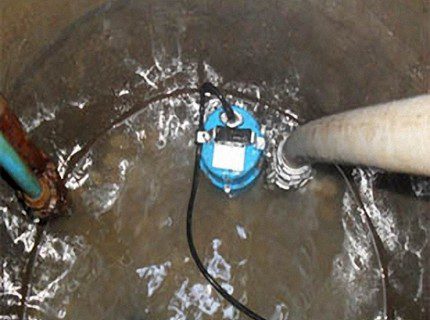
The well is cleaned, alternately including both units:
- drainage pump will free the well from dirty water;
- pressure pumpBy generating a dense stream, it will clean the walls and bottom of the tank.
You can manipulate the hydraulic nozzle, removing deposits from the walls of the mine, both from the ground and from the stairs. The dirt settled in the pumping process is removed manually, using a spray gun and special chemical compounds for this purpose.
During the procedures, it is necessary to lift the pump from time to time and clean the filter elements. The procedure is performed until deposits no longer form on the filters.
The overhaul of the hydraulic structure is carried out using more powerful pumps equipped with large filters that are able to pass through themselves contaminated water with inclusions of silty fibers. The procedure is performed in several stages, which may take up to 2-3 days.
After the completion of major cleaning, to maintain cleanliness in the mine, it should be launched once or twice a year. drainage pump. The frequency of the procedure depends on the characteristics of the soil.
Additional information on the selection of tools for cleaning wells is provided in this article.
Conclusions and useful video on the topic
One example of how to clean a mine well yourself using a drain pump:
When planning to clean the system manually in order to simplify their task, the masters recommend using a grader. Using such a small bucket, equipped with two locking blades, you can quickly and efficiently clean the bottom of the tank.
How to work with the tool is clearly described in the video:
The regular implementation of simple cleaning procedures for the well shaft will improve the flow of water and increase its quality characteristics.
Do you have personal experience with cleaning a well? Want to share effective methods or ask questions about the topic? Please leave comments and participate in discussions - the feedback form is located below.

 Do-it-yourself deepening of the well: a review of the best methods to get to the aquifer
Do-it-yourself deepening of the well: a review of the best methods to get to the aquifer  Digging a well with your own hands: types of well structures + an overview of the best digging technologies
Digging a well with your own hands: types of well structures + an overview of the best digging technologies 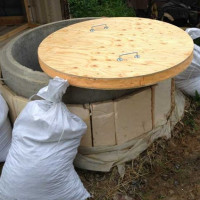 Do-it-yourself well warming for the winter: an overview of the best materials and methods of warming
Do-it-yourself well warming for the winter: an overview of the best materials and methods of warming 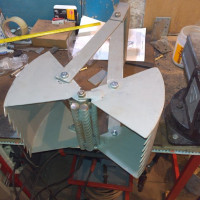 A review of the best tools for cleaning wells and how to use them
A review of the best tools for cleaning wells and how to use them  Do-it-yourself well cleaning: a review of common clogging causes and best cleaning methods
Do-it-yourself well cleaning: a review of common clogging causes and best cleaning methods 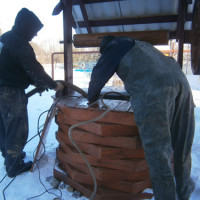 Water purification from a well: an overview of the best and most effective ways
Water purification from a well: an overview of the best and most effective ways  How much does it cost to connect gas to a private house: the price of organizing gas supply
How much does it cost to connect gas to a private house: the price of organizing gas supply  The best washing machines with dryer: model rating and customer tips
The best washing machines with dryer: model rating and customer tips  What is the color temperature of light and the nuances of choosing the temperature of the lamps to suit your needs
What is the color temperature of light and the nuances of choosing the temperature of the lamps to suit your needs  Replacement of a geyser in an apartment: replacement paperwork + basic norms and requirements
Replacement of a geyser in an apartment: replacement paperwork + basic norms and requirements
The pollution of a particular well depends on the owners themselves. If they did not take measures to protect themselves from external threats during the construction phase, then this is their problem. In our village, even the most dilapidated structures are still held, however, in most of them, the contents are no longer suitable for drinking. The tree is rotten and all that remains is to redo everything. The work is not easy, and it makes no sense to rebuild again, since there has been a running water for a long time.
Even a well-made well needs to be cleaned every 2-3 years. You can clean small wells yourself, it is better to call a specialist to clean a deep well. Earth gases, floating, collapse of the log house - saving is not worth the risk.
There is nothing complicated in cleaning the well, but still, inexperienced owners are better off calling the masters for the first time and carefully observing their actions. So I was an attentive spectator and after their work I even successfully successfully cleaned a well for my sister, who had a crack in the mine wall.The technique corresponds to the written, but you always need special attention to insurance and involve at least 2-3 people!
By the way, about the water supply - yes, it’s really convenient, but to the taste the water from the well is much more pleasant.